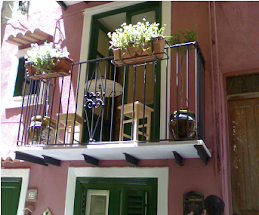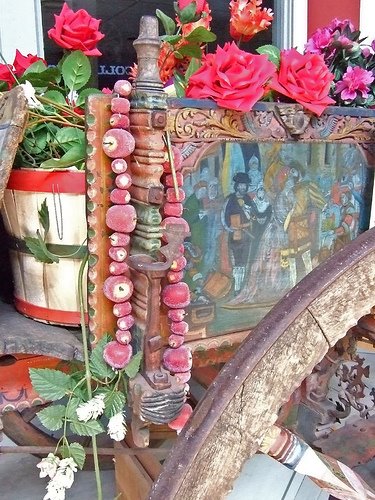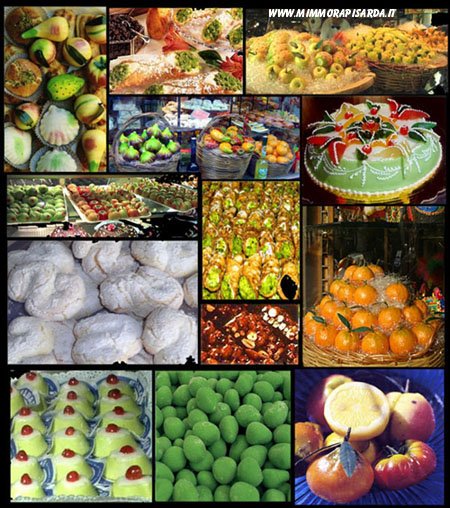 Source : London Sunday Telegraph
Source : London Sunday TelegraphMick Hucknall is best known as the singer with the pop group Simply Red but his Il Cantante label, produced in Sicily, is beginning to make music in wine circles.
Mick Hucknall bounded on to the stage in Verona, his audience's excitement followed by a reverent hush. "Il Cantante!" - "The singer!" - cried a breathless voice from the crowd.
The Simply Red vocalist was there not to sing, however, but to give a much-hyped debut to the first vino rosso produced from his Sicilian vineyard at Italy's most prestigious wine fair, Vinitaly.
The pop star has been nursing his grapes to maturity on the volcanic slopes of Mount Etna since the dawn of the new Millennium. First, he announced a successful 2001 harvest. Last year, he presented the label. Last week came the excitement of presenting the first vintage, appropriately called Il Cantante-Etna Red, though nicknamed "Simply Red" by locals.
In Verona, Hucknall savoured a mouthful of wine and relentlessly milked his "celebrity" connections. "I'm sure the wine will go down well with our Prime Minister, Tony Blair," he told the audience. "He's a good friend of mine and, like me, loves your country."
The crowd, as they say in showbusiness, went mad. "There's no question about it - it's an excellent quality wine with a robust structure, typical of some of the better examples to come from Etna's slopes," enthused Giuseppe Castiglione, the vice-president of Sicily's regional government and minister for agriculture.
"Mick's an extraordinary person," Mr Castiglione said. "He took part in every phase of the production, even choosing the terrain.
"A Sicilian can't help but be charmed by someone who comes from the world of showbusiness and falls in love with our land and goes about doing such a project so seriously. The result has been a great promotion for Sicily."
Hucknall is one of a growing list of showbusiness winemakers who have been wooed to Sicily, which is trying to shrug off its intimidating historical association with the Mafia.
Gerard Depardieu, the French actor, has bought vineyards on the Sicilian island of Pantelleria, while Lucio Dalla, an Italian singer, is producing rose close to Hucknall's 18th-century Etna Red estate.
As well as the well-known enthusiasts, serious wine-makers have also ventured to an island whose wines were once dismissed as being worthy only of being shipped to France to bolster the Bordeaux.
Gianni Zonin, the former head of Italy's wine producers' association, who entertained Mr Blair in his castle in 1997, is among the viniculturists drawn by the ideal growing conditions, comparatively low prices, and the tradition of local winemaking. As a result, the price of land planted with vines in the Etna area has shot up tenfold in 10 years, to euros 80,000-100,000 a hectare ($126,000 - $157,000). The first 6,000 bottles of Hucknall's Il Cantante-Etna Red, a full-bodied, medium-quality blend of local nerello grapes, will go on sale in Britain in September, along with 13,000 bottles of another Hucknall wine, Il Cantante-Nero d'Avola. For each bottle sold, Hucknall has promised to plant a tree.
He plans to have invested almost $4 million in the area by next year, planting another 2.5 acres of vines higher up the slopes of Etna at 1,200 metres above sea level - this time, of local carricante white vines. He also wants to increase his holding to 26 acres, in order to market olive oil as well as wine, and to buy, restore and rent out former vine-workers' cottages to tourists.
The singer's oenologist, Salvo Foti - considered the leading Etna wine specialist - praised Hucknall's "respect for the area and its traditions". Mr Foti said: "When he tried to enlist my services, I told him, 'If you're planning to produce something that breaks with tradition, you can go to someone else. I'm only interested if you make wine the way my father made it and his father did before him.'
"Maybe I was being a bit too hard. I had never heard of Mick Hucknall. Since the age of six I've been spending my life in vineyards. But he listened.
"Just as you can leave your mark with quality music which stands the test of time, you can too with a quality wine."
 The World Festival On The Beach is a large-scale sports and music festival that takes place each year in May in Mondello, Sicily. The World Festival combines windsurfing, sailing, beach volleyball, kitesurf, scuba diving, sky diving, paragliding and fitness in a single setting on the Mondello beach near Palermo. In addition to the sports competitions there are also concerts, fashion shows, fitness sessions and photographic competitions, which all together turn Mondello into a huge village that welcomes thousands of fans from all over the word day and night. Mondello Bay, whose waters are warm even in winter, is one of the most popular, famous resorts in Sicily. The World Festival on the Beach was created by Albaria Club, which has offered to organize a huge, competitive beach sports event for over twenty years. The festival's main events are the windsurfing and sailing competitions. The last edition of the Festival hosted the World Windsurf Championship and sailing competitions between the most famous crews from the America's Cup, and a stretch of the Isaf World's Match Race Circuit, level 1. The New Jazz Festival, a photographic competition with a lot of music and merriment complete the festival's programme, when the sun disappears and the beach is transformed into a dance-hall in the evening. All the events take place on the beach in a huge pedestrian area amidst the green vegetation. Access if free for tourists and Palermo inhabitants.
The World Festival On The Beach is a large-scale sports and music festival that takes place each year in May in Mondello, Sicily. The World Festival combines windsurfing, sailing, beach volleyball, kitesurf, scuba diving, sky diving, paragliding and fitness in a single setting on the Mondello beach near Palermo. In addition to the sports competitions there are also concerts, fashion shows, fitness sessions and photographic competitions, which all together turn Mondello into a huge village that welcomes thousands of fans from all over the word day and night. Mondello Bay, whose waters are warm even in winter, is one of the most popular, famous resorts in Sicily. The World Festival on the Beach was created by Albaria Club, which has offered to organize a huge, competitive beach sports event for over twenty years. The festival's main events are the windsurfing and sailing competitions. The last edition of the Festival hosted the World Windsurf Championship and sailing competitions between the most famous crews from the America's Cup, and a stretch of the Isaf World's Match Race Circuit, level 1. The New Jazz Festival, a photographic competition with a lot of music and merriment complete the festival's programme, when the sun disappears and the beach is transformed into a dance-hall in the evening. All the events take place on the beach in a huge pedestrian area amidst the green vegetation. Access if free for tourists and Palermo inhabitants.
























